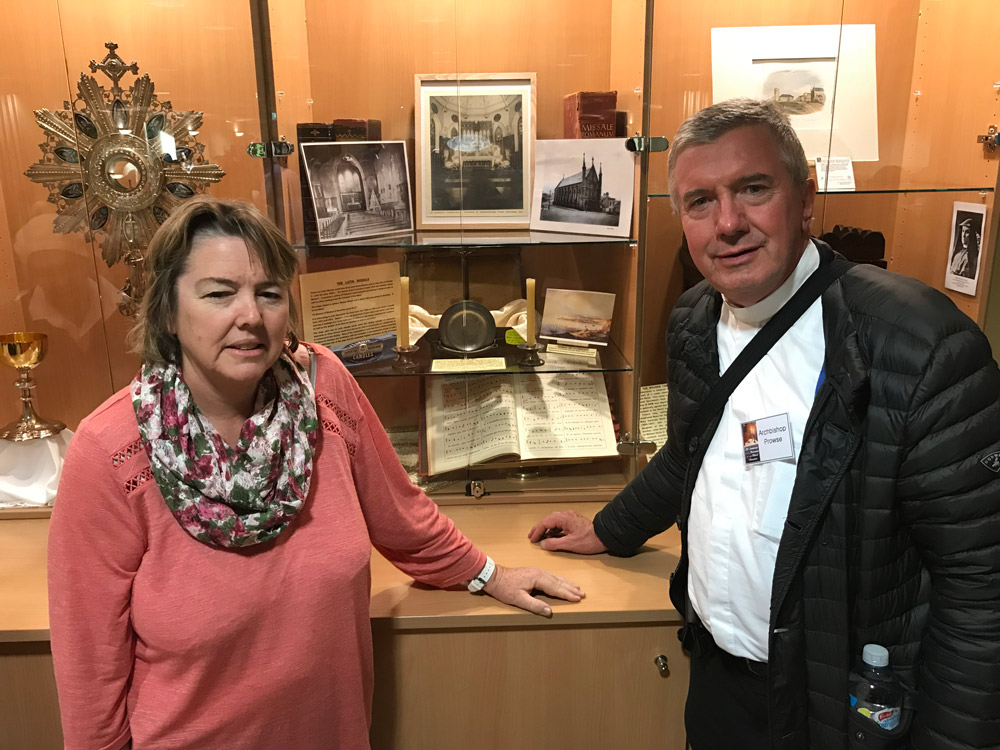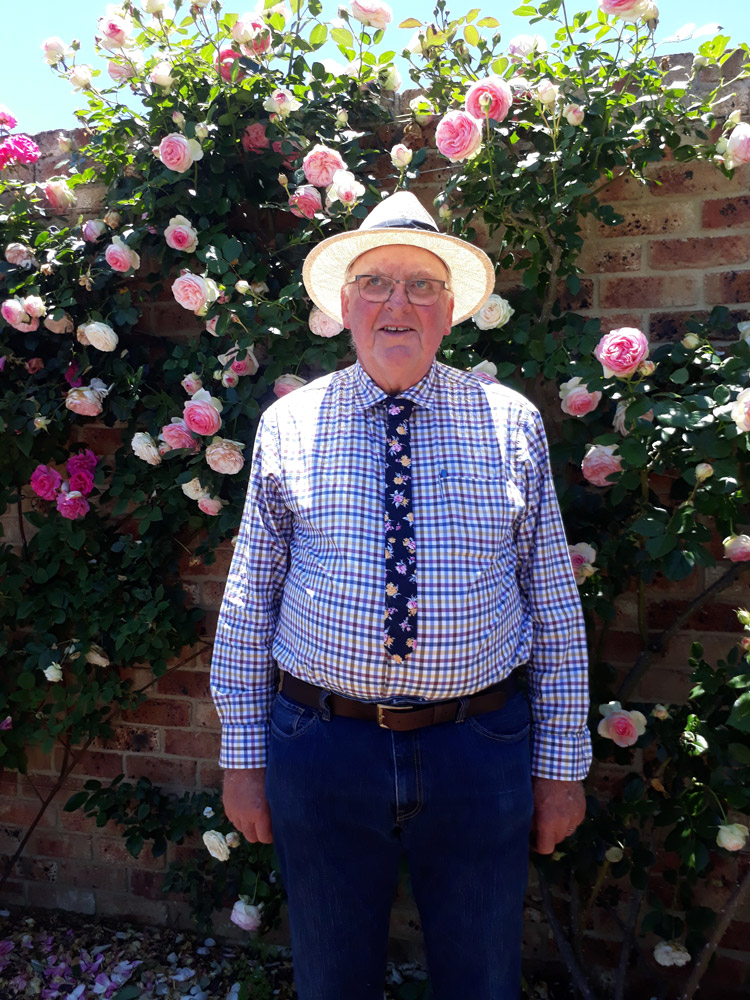200 Years of Eucharistic Adoration
Last month, Archbishop Christopher Prowse and many of the Catholic bishops of Australia took part in a celebratory Mass to commemorate 200 years of Eucharistic Adoration in Australia. Our Archdiocese has connections to the very early Church of Australia and to two of the pioneering families as John McLaurin discovers:
By JOHN McLAURIN
THERE is a long-held dispute among those concerned with the history of the Catholic Church in Australia, as to where pioneer priest Fr Jeremiah O’Flynn left the Blessed Sacrament when he was detained and deported from the colony in 1818.
The ever popular take over the past 200 years is that before departing Fr O’Flynn left the Blessed Sacrament at William Davis’ Cottage at The Rocks in Sydney. There also seems to be substantial enough evidence and it is accepted that a Consecrated Host was also left at James Dempsey’s house not far away in Kent St. Many historians agree that the Blessed Sacrament spent time in the homes of both Mr Davis and Mr Dempsey.
Both Mr Davis and Mr Dempsey were stonemasons in the early days of the colony. It is said that they were good friends. Records show that these pioneer Catholics were both very active in the early life of the Church in Australia. After eventually moving to Parramatta, Mr Davis donated his property at The Rocks for the building of what we still have as St Patrick’s at ‘Church Hill’ and the old Davis Cottage.
For many years the old ‘Davis Cottage’ has been known as the ‘Holy House of Australia’. Tours are conducted from there on a semi-regular basis.
The Davis connection

Archbishop Christopher Prowse with Jane Chifley at the 200th anniversary of Eucharistic Adoration in Australia. Picture: Supplied.
JANE Chifley, a former teacher at Sacred Heart Central School Cootamundra, says her distant relative – William Davis, had no direct descendants.
“His adopted son was killed when he fell off a horse in his twenties,” she said.
“He had a nephew John Davis, who we are descended from.
“My father’s maternal Grandmother – Granny Waters, was a direct descendant of John Davis.”
Miss Chifley says in Ireland during the days before William was sent to Australia, that he was a white or blacksmith and was arrested for suspicion of making things for the Irish uprising in 1798.
She also says he was flogged twice by Samuel Marsden – once for his faith according her late father.
“Dad also said that he [William Davis] kept the Blessed Sacrament in his house,” she said.
“People would come to his house to venerate the Sacrament and say the Rosary in front of it.
“This was during the time when there was no priest or Mass and it was kept fairly quiet amongst the Irish.”
Peter Breen in Northern NSW is another descendant of John Davis.
He has a set of William Davis’ Rosary beads.
- Miss Chifley, originally from Bathurst and now of Sydney, is also a grand-niece of Ben Chifley – the 16th Prime Minister of Australia.
The Dempsey connection

Dennis Dempsey authored the family’s history book of being in Australia. Picture: Supplied.
“History, our yesterday, is told today, so that it will be remembered tomorrow.” – (Dennis Dempsey 2002)
James Dempsey passed away in 1838 and was buried in Sandhills Cemetery (Central Station). His son Cornelius and his wife Jane (nee) McGuigan left Sydney settled at Emu Flat on the Upper Shoalhaven left Sydney and moved to manage a farm at Braidwood.
A number of his descendants still remain in the area including Dennis Dempsey, a current Braidwood parishioner.
Dennis authored the family’s history book of being in Australia.
He also wrote the following Letter to the Editor to The Catholic Weekly in 1998 although it was not published at the time.
The following is an extract of the letter which details parts of James Demspey’s life and the family’s claim to being left with The Blessed Sacrament in 1818:
In the many years that have elapsed since the Blessed Sacrament was left in Sydney, the Dempsey family have remained in the background, content with their own version of this event. We have the deepest respect for the early pioneers of the Catholic Church in Australia, people like James Dempsey, William Davis and the many others who gave selfless service to enable the religious freedom we enjoy today in this wonderful country.
We also respect the Davis family and in no way intend to denigrate their relatives’ contribution to the early history of the Catholic Church in Australia, but we would ask the Davis family to consider that others also hold claim to part of that history.
James Demspey arrived in Australia in 1802 after being transported for life for his part in the ill-fated 1798 uprising in Ireland. He left behind in Ireland a young wife he never saw again and four young children. The youngest son Cornelius, from whom I am descended, came to Australia on December 16 1821.
James Dempsey was a stonemason, and as such, was in great demand in the young colony. He was granted an absolute pardon on March 16, 1811.
We have documentary evidence that James Demspey (a lay Carmelite) practiced his religion very publicly, even during his term of sentence, when he accompanied the condemned to the scaffold praying with them to the end. James also opened his home in Kent Street as a ‘prayer and communications centre for the Irish and a base for a pious confraternity which he established. About 25 men with Dempsey at the head gathered for daily Rosary.
The Dempsey family also has documentary evidence that James Demspey opened his home to the sick and needy, and on Sundays travelled from as far as Parramatta and Campbelltown to take part in a paraliturgy based on the Mass, and also for prayers at times when the colony was priestless. Mass, Confessions and other religious ceremonies were conducted by Fr Therry and Fr O’Flynn in James Dempsey’s house before Australia had a church.
When Fr Jeremiah O’Flynn, the first free Catholic priest in Australia was deported in 1818 at short notice, he left behind the Blessed Sacrament.
Dempsey oral family history (confirmed recently by the two most senior members of the family) says that Fr O’Flynn was in the process of ministering to the sick when he was advised of his imminent arrest. He went quickly to the nearest house (James Demspey’s Kent St residence) and left the pyx and its precious contents there before moving to a more public place where he was arrested.
Dempsey oral family history then stated that the Blessed Sacrament was moved from house to house to ensure that it was undiscovered by the authorities.
In all probability the Blessed Sacrament was at James Demspey’s house and William Davis’ house at different times, and at ‘safe’ houses in between. Common-sense would suggest this was the most likely thing to have happened.


